Contrary to popular belief, skinny beginners do not need a gym membership (or even weights) to get bigger and stronger. In fact, most forms of intense physical exercise are sufficient to improve your physique. You can try this home bodyweight workout to build muscle without weights.
Program Overview:
- Complete 3 workouts per week with at least 24-48 hours of rest between training days.
- Focus on compound calisthenics movements to build muscle efficiently.
- Workouts should not last more than 30-45 minutes.
- Ensure each exercise is performed at a high intensity for the best results.
- Get a bigger chest, shoulders, arms, and legs within 1-2 months.
As an ex-skinny guy myself, I found bodyweight (calisthenics) training to be safe, convenient, and most importantly, effective. Below, you’ll find out exactly how to make muscle gains if you don’t have weights!

- Why It's Possible To Build Muscle With Home Bodyweight Workouts
- Best Bodyweight Exercises To Build Muscle At Home
- Home Bodyweight Workout To Build Muscle
- How To Perform These Bodyweight Exercises
- Is It Better To Use Free Weights Or Bodyweight?
- How Big You Can Expect To Get From Bodyweight Workouts?
- Conclusion
Why It’s Possible To Build Muscle With Home Bodyweight Workouts
Muscle can be gained without weights. Bodyweight exercises are effective for getting bigger and stronger at home as long as the movements are performed at a sufficiently high intensity. Effective exercises include push-ups, squats, lunges, pull-ups, and crunches.
Take a look at this 2017 study. Here, 18 recreational exercisers were split into two groups. Group 1 was put on a push-up program, whereas group 2 went on a barbell bench press program (intensity at 40% of 1RM intensity).
Both groups completed 2 workouts per week for 8 weeks.
Results? Both groups saw similar size/strength gains in their pecs and triceps.
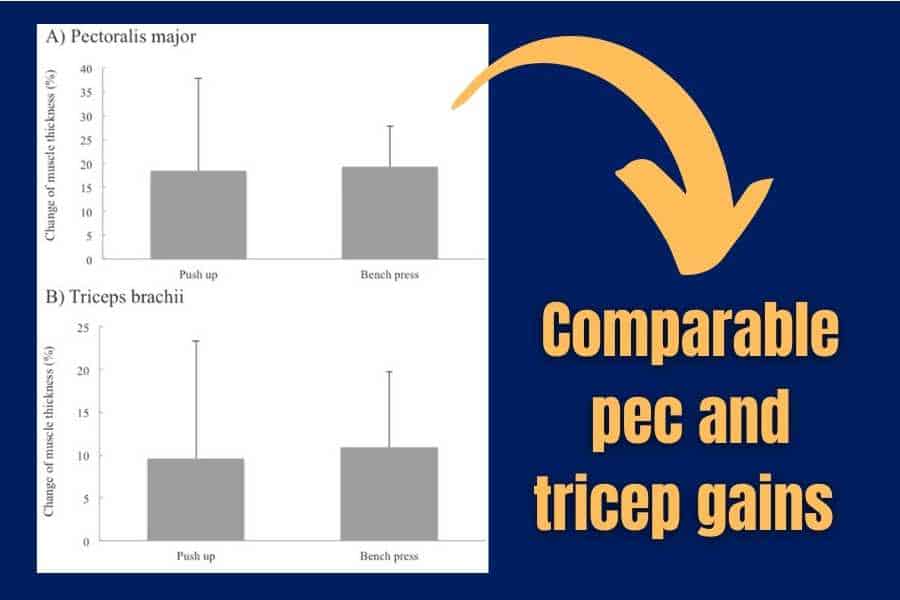
This suggests that bodyweight workouts can be just as effective as free weights for building muscle and strength.
The truth is that as a beginner, your untrained muscles are more responsive to growth compared to trained lifters. And most types of workouts (including bodyweight exercises) are effective for building muscle. But it’s essential to perform them at a high intensity.
The below bodyweight workout will help skinny people get bigger and stronger at home.
Best Bodyweight Exercises To Build Muscle At Home
The best bodyweight exercises to gain muscle include:
| Bodyweight Exercise | Primary Target Muscle | Secondary Target Muscle |
|---|---|---|
| Squat | Quadriceps, hamstrings, glutes, calves | Abs |
| Lunge | Quadriceps, hamstrings, glutes, calves | Abs |
| Push-up | Pectorals, deltoids | Triceps |
| Dips | Pectorals, deltoids | Triceps |
| Plank | Full-body | Full-body |
| Pull-up and chin-up | Latissimus dorsi, trapezius, rhomboids | Biceps |
These are all compound exercises, meaning they work multiple muscles in a single movement. Most bodyweight exercises are in fact compound by nature, making them particularly effective.
Next, I’ll show you how to perform these exercises in a full workout program.
Home Bodyweight Workout To Build Muscle
The bodyweight workout (no weights required):
| Exercise | Sets | Reps | Inter-Set Rest |
|---|---|---|---|
| Traditional push-up | 3 | 15 | 1 min |
| Jump squats | 4 | 10 | 1 min |
| Pull-ups (or superman extension) | 4 | 8 | 1 min |
| Diamond-hand push-up | 3 | 10 | 1 min |
| Star plank | 4 | 20 seconds | 1 min |
Time To Complete:
Each workout takes ~25 minutes from start to finish. This is a good workout duration for beginners to begin with. Also bear in mind that total workout time is largely influenced by how long you rest between sets (inter-set rest). Aim for a 1-minute rest, to begin with, and increase/decrease to suit your fitness levels.
How It Works:
The same workout is to be repeated 3 times throughout the week.
Take a 24-48 hour break between workouts (this is crucial). Rest days are important for muscle recovery and repair, leaving you fresh and able to max out your intensity for the next workout. For more information, you can go to my other post on the recommended number of days to train.
Complete the recommended number of sets and reps for each exercise. For example, 3 sets of 15 mean doing 15 consecutive repetitions before taking a 1-minute rest to finish the set and moving on to the next set.
Move on to the next exercise after you’ve completed the allotted sets.
I also recommend sticking to the exercise order given. I’ve purposefully designed it so that similar muscle groups aren’t worked one after the other. This gives your body the maximum amount of time to recover between exercises.
Recommended Reps:
This bodyweight workout routine gives you rep recommendations for each exercise. But these are only general recommendations for an average skinny beginner.
In practice, you may find the recommended reps too hard/easy (depending on your fitness level). This makes it important to adjust the reps as you proceed with the workout.
Generally speaking, the last few reps of a set should feel challenging. For example, you should feel a muscular fatigue or “burn” by rep 12 if you’re aiming to complete 15 reps in total. This ensures you’re training at the right intensity for muscle growth.
The star plank comprises a single rep held for 20 seconds.
Bodyweight Exercise Alternatives:
There are many bodyweight exercises you can do to build muscle at home if you don’t have weights. The ones featured in this workout are simply the ones I found most effective.
Therefore feel free to substitute your own exercises.
I would recommend swapping exercises based on muscle group though. For example, if you don’t like the push-up, you can swap it for another chest-based bodyweight movement.
You’ll also notice that the workout features pull-ups even though it’s supposed to be a no-weights/equipment routine. I decided to include pull-ups because it’s honestly one of the best exercises you can do without weights. Pull-up bars can be found online relatively cheaply.
If you don’t like pull-ups, you can substitute them for superman extensions (not as effective but more convenient to do).
How To Apply Progressive Overload:
Overloading is when you increase exercise intensity as you get stronger over time. It’s essential for skinny beginners to continue building muscle.
Sticking with the same workload simply won’t cut it for muscle growth, regardless of your training method or whether you’re working out at home or at the gym.
The best bodyweight progressive overload techniques are slightly different compared to weight lifting:
- Increase reps. Add 1-5 extra reps at a time. For example, if 10 reps of squats are a breeze, then try doing 13 reps on the next set. Remember, the aim is to find the ideal rep range that you find challenging.
- Increase sets. Adding an extra 1-2 extra sets is fine if you’re looking for a challenge. But this can significantly increase workout duration. So I prefer utilizing the other overload methods in this list.
- Decrease rest. For example, reduce the 1-minute rest between sets to 30 seconds. This works well if you have strong cardio fitness. It’s also great for skinny-fat people looking to burn calories and build muscle at the same time.
- Reduce tempo. An average rep takes ~2 seconds to complete using a normal tempo. You can consciously slow things down to 4-6 seconds per rep to really increase intensity. In a push-up example, the downward and upward phases could be reduced to 3 secs each (6 secs total). This method is highly effective for maximizing muscle gains using home bodyweight workouts.
- Use pause-reps. Hold a movement for 1-2 seconds at the contracting phase of each rep. In a push-up example, lower yourself down and stop and hold the bottom position before driving back up. This is another great way to drive maximal muscle gains with bodyweight exercises.
You can check out my other post for more details on how to increase bodyweight exercise intensity.
Generally speaking, you should aim to overload once every 1-3 workouts or whenever you feel physically capable of doing so.
How To Perform These Bodyweight Exercises
A) Traditional Push-Up
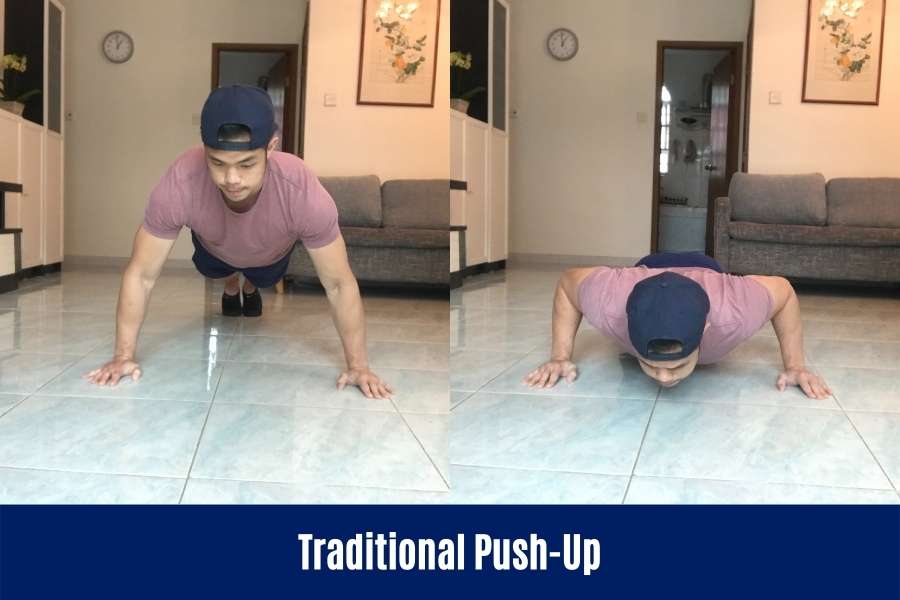
One of the best bodyweight exercises for the upper body. The humble push-up is a staple upper-body exercise if you don’t have weights at home.
If you can already perform >15 consecutive reps, then great. Increase difficulty by applying the methods detailed in the section “how to apply progressive overload”.
But if you struggle with this exercise, it’s ok to start with kneeling push-ups. Slowly increase reps until you can do ~25. By this point, you should be able to switch to the traditional push-up.
B) Jump Squats
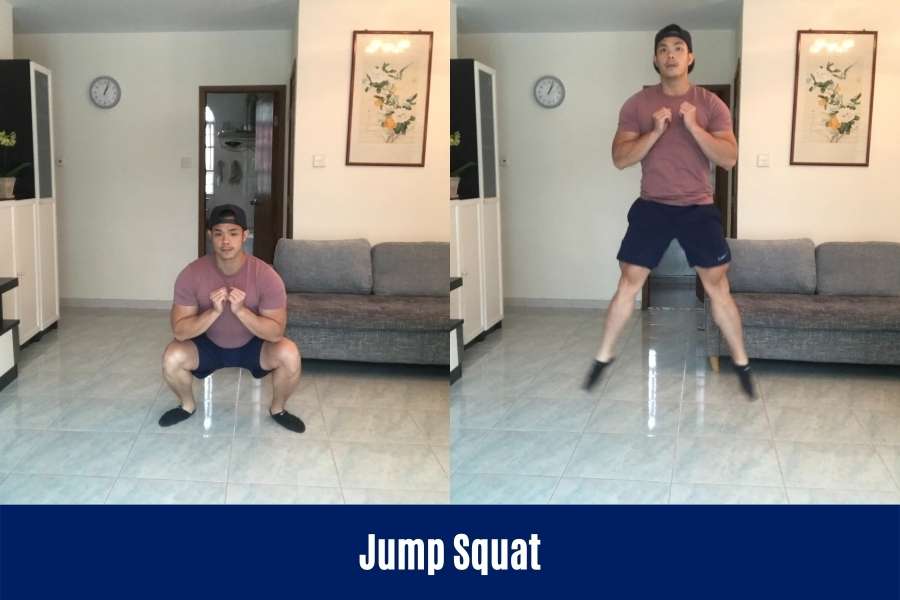
Even the skinniest of beginners are usually able to do bodyweight squats with relative ease. The jump squat is the next level up.
From the bottom of a squat, drive explosively upwards into a jump before landing back on your feet. This is a much harder variation of the traditional bodyweight squat.
It’s a great way to build bigger legs at home if you don’t have free weights.
C) Pull-Up

Pull-ups are my favorite bodyweight exercise to build a bigger, stronger, and broader back.
The average beginner won’t be able to do unassisted pull-ups. You can start with these assisted variations instead:
- Negative pull-ups- use a chair to enter the top position and slowly lower yourself down.
- Jumping pull-ups- use the momentum of a standing jump to help you reach the top of the bar.
- Banded pull-ups- wrap a resistance band around the bar and loop the other end around your buttocks.
The aim is to gradually increase pulling strength as you get used to the movement. Slowly increase assisted reps until you can do unassisted pull-ups.
Pull-up bars are relatively cheap. But if you don’t want to invest in one, you can do the superman extension instead to work your back muscles (see next).
D) Superman extension

The back can be difficult to build without a pull-up bar. But the superman extension engages all your major back muscles.
Most people will find this bodyweight exercise easy to perform. But that makes it unideal for muscle growth.
I would recommend applying the methods detailed in the section “how to apply progressive overload” to increase the intensity.
E) Diamond-hand push-up

This push-up variation switches emphasis from the pecs to your triceps. I like to complete these after my chest has already been worked by sets of traditional push-ups.
This is a great way to really fatigue your pecs and hit your triceps at the same time.
The diamond push-up is one of the best bodyweight exercises to build ripped arms.
F) Star plank
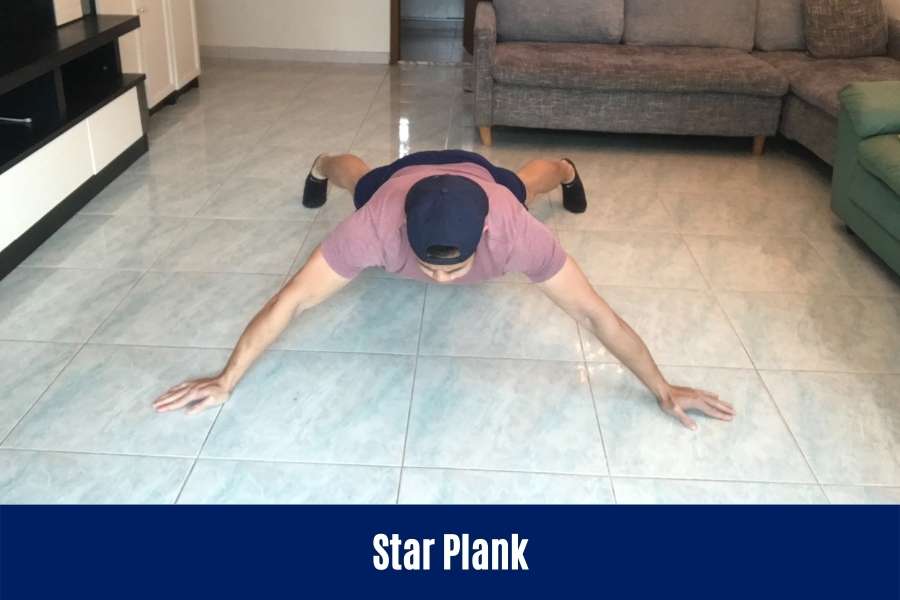
This exercise works your whole body in a completely different way.
Holding a star plank engages your muscles in an isometric contraction (like how a rugby player pushes against an opposing scrum). And this novel stimulus can help to grow your muscles.
If the star plank is too hard, try mastering the normal floor plank first.
Is It Better To Use Free Weights Or Bodyweight?
Weight training is generally superior to bodyweight workouts for building muscle. The external load provided by weights makes it easier to apply progressive overload. However, bodyweight workouts are still effective for beginners to get bigger and stronger if they are performed at a high intensity.
Speaking from experience, bodyweight workouts can be extremely effective when done right (especially for untrained skinny people whose muscles respond to most types of physical exercise). And let’s not forget it’s completely free to do.
However, it can also be difficult for a beginner to apply progressive overload correctly.
This is unlike weight training, where you simply increase the weight lifted (something you can’t do easily with bodyweight exercises).
If you have dumbbells available, then you may be interested in my other post for a skinny guy home dumbbell workout.
How Big You Can Expect To Get From Bodyweight Workouts?
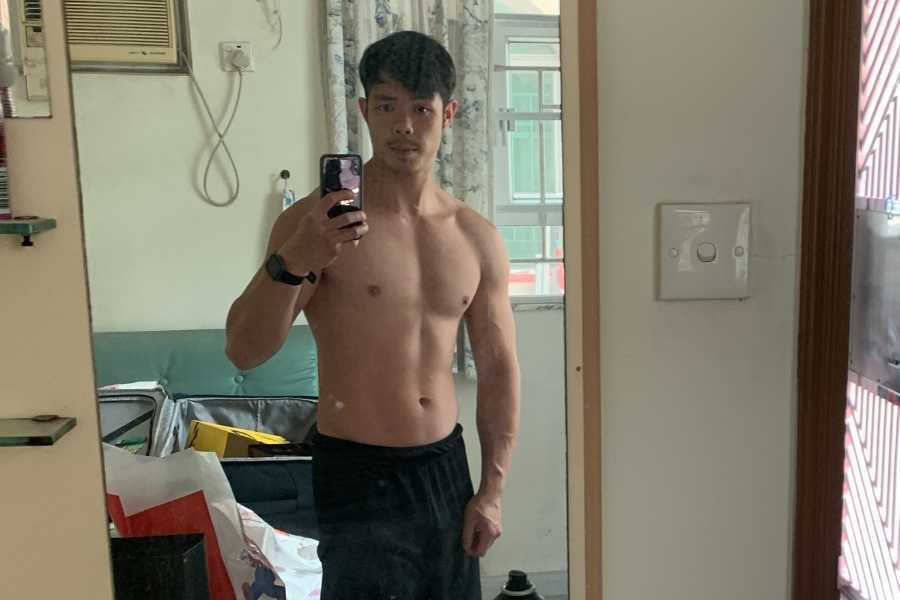
Beginners can use bodyweight exercises to build a significantly bigger physique. However, it is essential to train at a high intensity and apply progressive overload. Free weights are generally better for people looking to maximize muscle growth.
My advice- try my home program and see how you like it.
When performed correctly, bodyweight training help people:
- Build bigger muscles.
- Increase strength.
- Gain definition and tone.
- Get more ripped.
Just don’t expect to get bodybuilder-jacked or build the strength of a powerlifter!
It’s also essential to go on bulking diet if you want to add significant amounts of mass. For more details, you can find my home muscle-building guide for skinny guys here.
Conclusion
I’ve shared a bodyweight workout to help you build muscle at home.
It’s a 3-day routine that any beginner can safely try without weights. The routine focuses on some of the most popular and effective calisthenics movements with progressive overload to drive hypertrophy.
When performed right (remember high-intensity is key!), you can expect to get bigger, stronger, and more ripped.
You may also be interested in the downloadable Kalibre Blueprint PDF which details exactly how I gained 40lbs of lean muscle (it’s 100% free!). It details the exact exercises and nutrition (with printables) I used to go from skinny to ripped!


